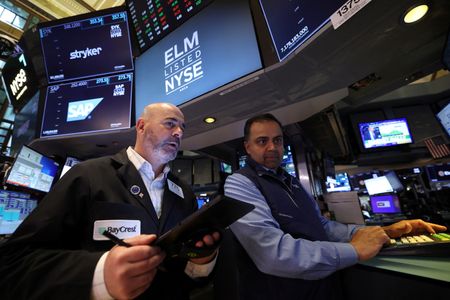By Rae Wee
SINGAPORE (Reuters) -Stocks drifted on Thursday and a rebound in the dollar lost traction as investors tried to sift through the noise from the Trump administration and its fickle stance on tariffs and the Federal Reserve’s leadership.
Just this week, U.S. President Donald Trump has rained attacks on Fed head Jerome Powell, then retracted calls for the chair’s resignation, and left investors none the wiser on the ultimate state of tariffs on China despite many headlines around it.
The Trump administration would look at lowering tariffs on imported Chinese goods pending talks with Beijing, a source told Reuters on Wednesday, after a Wall Street Journal report that the White House is considering cutting its tariffs on Chinese imports.
But Treasury Secretary Scott Bessent later said that such a move would not come unilaterally, echoing comments from White House spokesperson Karoline Leavitt.
“I don’t think you can ever get used to the sorts of haphazard and flip-flopping that we’ve seen. It’s extreme,” said Tony Sycamore, a market analyst at IG. “I think that’s Trump – he wants to try and find the right levers to pull, and I don’t think he’s scared of trying something, and I don’t think he’s scared of walking it back if it doesn’t work.”
MSCI’s broadest index of Asia-Pacific shares outside Japan fell 0.4%, bucking the trend on Wall Street after stocks advanced on Wednesday on hopes for a de-escalation of Sino-U.S. trade tensions.
U.S. futures pared gains from earlier in the session with Nasdaq futures losing 0.24% and S&P 500 futures down 0.15%. EUROSTOXX 50 futures <STXEc1> rose just 0.08%.
The Nikkei gained 1%.
Japan’s tariff negotiator Ryosei Akazawa is making final arrangements to visit the United States from April 30 to hold a second round of talks with his counterpart, two sources familiar with the matter said on Thursday.
In China, the CSI300 blue-chip index was up 0.24%, but Hong Kong’s Hang Seng Index slid 0.7%.
“Short-term volatility is quite extreme right now… this high volatility is going to sustain, you have elevated volatility going forward, because the underlying foundational rules of the game are changing… the economic world order is changing,” said Salman Ahmed, global head of macro and strategic asset allocation at Fidelity International.
“I think what is clear is that we are past peak globalisation, all that kind of free flow of trade and capital is not going to be the steady state,” said Ahmed, speaking on the sidelines of the IMAS Investment Conference and Masterclass 2025 in Singapore.
The dollar lost some ground on Thursday, after a rebound this week on relief over Trump’s U-turn on axing Powell, as investor confidence in U.S. assets stayed fragile.
Against the yen, the dollar fell 0.5% to 142.75. The euro was up 0.32% to $1.1350, while the Swiss franc rose more than 0.3% to 0.82795 per dollar.
Longer-dated Treasuries steadied as Trump’s reversal on Powell seemed to ease the threat to U.S. monetary and fiscal credibility, with the 30-year yield little changed at 4.7980%. [US/]
The benchmark 10-year yield was down about 3 basis points to 4.3578%.
Federal Reserve Bank of Cleveland President Beth Hammack said on Wednesday major uncertainty over the outlook continues to argue for the central bank taking it slow on monetary policy to see how the economy performs.
Markets are pricing in slightly more than 80 bps worth of rate cuts by December.
Elsewhere, oil prices steadied after a fall in the previous session as sources said OPEC+ would consider accelerating its oil output increases in June.
Brent crude futures ticked up 0.08% to $66.17 a barrel, while U.S. crude similarly rose 0.03% to $62.29 per barrel. [O/R/]
Gold resumed its advance towards a record high, with the yellow metal last up 1.6% at $3,340.29 an ounce. [GOL/]
(Reporting by Rae Wee, Editing by Gerry Doyle)










